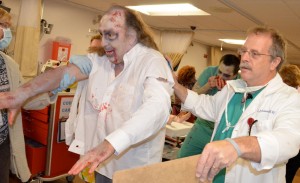It was up to just two-dozen nursing educators visiting Drexel University from across North America to quell the zombie outbreak that struck the campus Aug. 15, with waves of the undead escaping from their designated morgue and demanding brains.
This simulation kickstarted a weeklong certificate program on clinical simulation at Drexel’s College of Nursing and Health Professions, headed by Carol Okupniak and John Cornele, program organizer and simulation coordinator, respectively.

“It caused pandemonium, confusion and a lack of resources, all of which we then used as educational points for the rest of the week on how to build realistic simulation, and that’s kind of why we did it,” Cornele explained.
Okupinak came up with the simulation idea while looking at the website of the Centers for Disease Control and Prevention.
“The website actually had a ‘How are you going to prepare for the zombie apocalypse?’ prompt,” Cornele said. “The CDC is using the prompt to teach people about disaster protocol, but it also caught Carol’s attention because of the subject matter,” he continued.
A week before the certificate program, Cornele began instructing actors and developing the simulation so that it would be ready in time for the participants.
The attendees, many of whom already run nursing simulation centers across the country and in Canada, visited Drexel in order to perfect the craft, according to Cornele.
At the start of the program, participants were literally pulled from their first lecture in groups of 12 to deal with an emerging situation of an undisclosed nature.
“We had them begin to take care of the computerized mannequins that were made up to be zombies in the first stage of the infection,” Cornele said. “While they were getting their assessments and getting vital signs, Carol alerts the second group of 12 that there were unidentified bodies in the morgue.”
This time, the bodies were actual actors, also made up to resemble zombies. As instructed by Cornele in an earlier run-through, the zombies sprung to life, wandered around the emergency room and searched for brains.
Cornele and his team had previously hid gelatin in pillowcases to serve as brains, which the zombies then clamored for during the simulation. Soon the zombies found the ‘brains’ and began to eat.
“Here the simulation became about ‘How do you manage a disruptive patient? How do you complete the task?’” Cornele said. “Eventually the participants got smart and used the gelatin brains to lure the zombies back to the morgue where they were supposed to keep them.”
When the simulation ended, the visiting educators were brought into a room and debriefed. Okupniak and Leland Rockstraw explained to the participants the methodology of the exercise and allowed them to describe their reactions to the process.
“We were trying to create a little confusion among the participants just to show how that can impact what they had to do,” Cornele explained. “In disaster situations things always come at you in an unorganized fashion, but if you’ve seen it before maybe next time you’ll be a little more effective.”
The rest of the week’s events were lectures and informational sessions that informed the nursing professionals about how to effectively run such a simulation. The participants were even given the opportunity to compose and direct their own scenarios to gain experience.
Cornele and other members of the College of Nursing and Health Professions have successfully completed three clinical simulations thus far, and are already booked for three more in 2012.
“Certainly we’re going to use a mass casualty event in the future; the question is what will be the trigger?” Cornele said.


